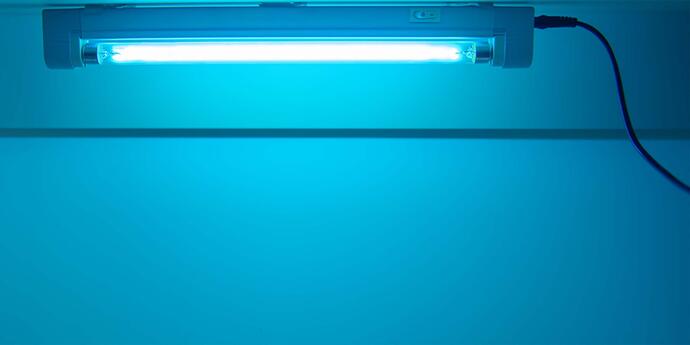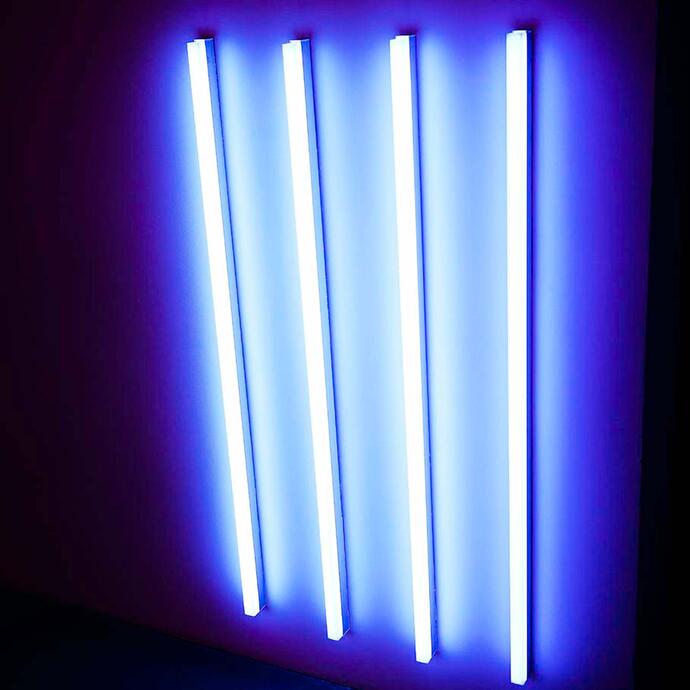We are all seeking newer and safer ways to interact with the world around us, and revisiting possible strategies for disinfecting the indoor environment is a big part of that discussion.
In the midst of this quest for the most effective possible infection control, ultraviolet (UV) disinfection has emerged at the forefront of the conversation. UV technology that boasts quick and effective disinfection is flooding the market for commercial and personal use.
However, in the shadow of this solution you will still find many questions. Misunderstandings surrounding the appropriate implementation of Germicidal Ultraviolet (GUV) could lead to ineffective infection control procedures or, if not operated effectively, skin and eye damage in operators and occupants. It’s important to understand and explore the many available uses and limitations of GUV.
“How does UV disinfection work exactly?”
Ultraviolet, or UV, light is a form of electromagnetic radiation with wavelengths shorter than visible light but longer than x-rays. As a radiation, UV has been shown to degrade DNA (making it effective against bacteria and spores) and inactivate RNA (making it effective against viruses such as SARS-CoV-2). UV light is often misunderstood as “that blue light”, but that is not quite correct. The light we see is not UV, but rather lets us know that UV is present.
There are three bands of UV light: UV-A, UV-B, and UV-C. As the least harmful and most effective for disinfection, UV-C (200nm to 280nm) is the band or range of light that is most commonly used in GUV disinfection systems.
To date, UV disinfection can be applied in a variety of ways, predominantly falling into two main system design approaches:
- In Ventilation Systems, in air handling systems or on duct surfaces, as discussed in our article “Limiting the Spread of Airborne Pathogens through Mechanical Design”)
- In Room Systems, which can include upper room strategies (air), and whole room strategies (air and surfaces). Through upper room strategies, the UV-C source is positioned at least seven feet high and directed at the ceiling to irradiate air as it circulates. Such positioning prevents direct eye contact with the light beam. This is most effective when there is constant air-mixing by fans and HVAC ventilation, but even without strong ventilation or fans, air constantly mixes by movements and normal convective currents. Through a whole room strategy, downward UV-C radiation could be used to disinfect exposed surfaces, but the room would need to be unoccupied, and there are many factors associated with this approach that would need to be considered.
When it comes to in room systems, the effectiveness of UV disinfection is heavily influenced by the appropriate dosage strategy, such as the most appropriate air-mixing when applied through upper room disinfection. UV systems also need to be cleaned and checked on a regular basis in order to be effective. Fluorescent UV lamps – which are the most common and effective lamp types for GUV – must be replaced on an annual basis. LED lamps are a poor source of UV (encompassing UV-A, UV-B, and 405nm spectrums) and, according to the Illuminating Engineering Society (Committee Report on Germicidal Ultraviolet (GUV) Frequently Asked Questions, April 15, 2020), they have not been developed to a stage where widespread implementation is encouraged.
UV lighting is a complementary disinfection feature that does not remove the need for standard cleaning protocols. Particularly in whole room strategies, areas to which these solutions would be applied would need to be cleaned first in order for the UV light to be effective. Duration of light exposure is also a factor to be considered, and some systems do require between six and 24 hours of operation to kill 99% of the pathogens.
“Isn’t UV dangerous?”
Yes - UV light is a hazardous wavelength of light. The biggest concerns surrounding the use of GUV stem from accidental exposure to the skin and eyes. However, like any hazardous material, it can be used effectively if the appropriate safety protocols are followed.
The source of the light itself is what can be harmful, not the “glow” or the reflection. Even as the least hazardous band, UV-C direct exposure can lead to uncomfortable eye conditions such as photokeratitis (also known as "welder’s flash") or photoconjunctivitis if the luminaire is operated improperly. There is a balance of exposure duration and light intensity that may vary, and must be verified case-by-case for effectiveness. Verification and measurement are key tools in supporting the effectiveness of GUV upper room or whole room strategies.
UV light is harmful at close distances (less than 25cm) so, depending of the situation, even from “safe” manufacturer fixtures, there may be on site issues if operations and maintenance staff are not appropriately trained. Another challenge is that glass (4mm or more) and some special acrylics can completely block UV. Therefore, to a certain degree, the light source must be exposed in order to be effective, making it more dangerous. UV light also reacts with oxygen to create ozone, which is a toxic gas. This reinforces the need for proper ventilation in any room with GUV systems. Material discoloration, and the potential to make plastic or acrylic materials brittle are additional design considerations when working with GUV systems.
Questions that speak to these UV concerns must be addressed by manufacturers before moving forward with upper or whole room UV disinfection strategies.
“What can be disinfected by UV light?”
GUV has been used to disinfect surfaces, water, and air for decades. Before antibiotics and vaccines, UV air disinfection was widely used in schools, hospitals, and other public buildings.
As an effective disinfection strategy, the IES recommends the use of GUV technology in upper air germicidal fixtures only, to minimize the direct view of the light source. In terms of a surface cleaning measure, GUV is typically used as a supplementary control measure for disinfection, as it cannot actually penetrate surfaces, or and cannot disinfect soiled surfaces. GUV is a line-of-sight technology, meaning that all bacteria and viruses in the "shadows" are not being affected or killed. It can be compared to how an infra-red motion sensor works, where the sensor is not effective if your movement is outside its line-of-sight. If you were to apply GUV to an upright bowl sitting on a table, for example, it may disinfect the top (exposed surface) of the bowl, but not the underside of the bowl, or any part of the table underneath that the bowl is blocking.
“Is GUV an appropriate solution for my building?”
Like all infection control measures, GUV is not a stand-alone unto itself, but may be an important piece for some owners and operators as part of a larger infection control strategy. GUV may be considered as an additional procedure, but should not exclude the need for traditional cleaning methods.
When considering whether or not GUV will work for a particular space, there are five main considerations:
- Owner Intent: The type of space that the solution is proposed for, as well as the ultimate purpose of the space, is a critical consideration that must be discussed with the owner and operator prior to implementing a GUV solution.
- Risk Assessment: Do the pros of GUV outweigh the cons, and will effective procedures surrounding the technology be put in place? These are critical questions to ask before moving forward with this solution.
- Life cycle costs: It’s important to keep in mind that GUV does consume more energy than alternative lighting solutions, and an energy modelling analysis is likely required to understand the exact impact on a particular building. Maintenance costs that are assumed in order to maintain effectiveness of the lamps (i.e., replacing fluorescent lamps once per year) must also be taken into consideration.
- Maintenance Procedures: Are resources available to put the adequate training in place for operations and maintenance staff? A thorough training program would be required, with a clear understanding of what is required for every role interacting with the system – from those replacing the bulbs, to those cleaning the fixtures. If cleaning is not performed, it will drastically reduce the effectiveness of the UV to the point where it may no longer be effective. In addition to user safety, the effectiveness of GUV is significantly limited by factors that may be overlooked if appropriate training isn’t in place, such as the solution used to clean the bulbs.
- Other Control Measures: Particularly when leveraging a whole room strategy, a full understanding of the infection control measures to be implemented must be in place before moving forward as a failsafe to protect occupants. Misunderstanding what is required can limit the efficacy of GUV which, if solely relied upon, could lead to in-effectively cleaned indoor environments.
While research around GUV as applied to surface disinfection continues, new technology appears on the market and in commercial spaces all the time. Reports of “at home” UV technology that is sold online is increasingly reported with low efficacy for actual disinfection in the absence of a proper meter or detector, and poses a serious danger to users in light of warning labels that are often not sufficient or clear. Still, there are many possibilities proposed by this technology.

In response to the COVID-19 pandemic, the Illuminating Engineering Society (IES) put out a Committee Report on April 15, 2020 on Germicidal Ultraviolet (GUV) Frequently Asked Questions. In this report, the IES points out that:
“Upper-room GUV air disinfection is a primary means of safe and highly effective air disinfection, provided it is planned, installed, commissioned, and maintained according to current international standards…There is no reason not to make full use of GUV with appropriate precautions in this “war” against COVID-19.”
While some modes of implementation may be more limited than others, it’s important to explore every available option and work together to build brighter strategies.

